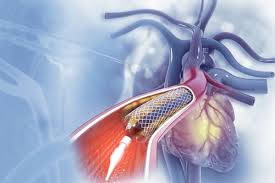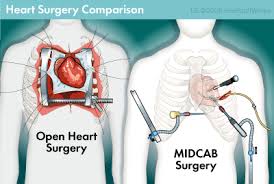Imagine feeling a sudden, sharp pain in your chest and being rushed to the hospital. The doctor tells you that you need surgery—but should it be a bypass or open-heart surgery? What’s the difference? The difference between bypass and open heart surgery is crucial to understand for those facing heart issues.
An poor lifestyle, a genetic predisposition, or medical conditions can all contribute to the development of heart-related problems over time. The human heart is an essential organ that makes sure that oxygen-rich blood circulates throughout the body.
Among the most common heart procedures are bypass surgery and open-heart surgery. While these terms are often used interchangeably, they are distinct procedures with different applications, techniques, and recovery processes.
In this article, we will explore the difference between bypass and open heart surgery, shedding light on their unique aspects and helping patients understand which procedure may be more suitable for their condition.
What Is Bypass Surgery?
Bypass surgery, also known as coronary artery bypass grafting (CABG), is a procedure that increases blood flow to the heart. It is often indicated for patients with severe coronary artery disease (CAD), which occurs when the coronary arteries constrict or become blocked owing to plaque buildup. During the surgery, a surgeon takes a healthy blood vessel from another part of the body (such as the leg, arm, or chest) and grafts it onto the blocked artery, establishing a new conduit for blood to flow to the heart.
Bypass surgery is typically performed under general anaesthesia and requires the use of a heart-lung machine. However, in some cases, an off-pump procedure, also known as “beating-heart surgery,” may be used, in which the heart continues to beat during the surgery.
Fun Fact: Did you know? Over 200,000 bypass surgeries are performed in the U.S. every year!

What Is Open Heart Surgery?
Open heart surgery is a broad term for any surgical procedure that involves opening the chest and performing surgery directly on the heart. It covers a wide range of procedures, including valve repairs, heart transplants, congenital heart defect treatments, and bypass surgeries. The term “open heart” does not necessarily suggest that the heart is literally cut open; rather, it implies that the chest cavity is reached through a sternotomy (an incision through the breastbone).
Most open-heart surgeries need the use of a heart-lung machine to temporarily take over the function of the heart and lungs. This allows the surgeon to operate on a quiet and bloodless field, ensuring precision and safety during the procedure.
Did You Know: Open-heart surgery was first performed successfully in 1952, while the first coronary bypass surgery was done in 1960.

Key Difference Between Bypass and Open Heart Surgery
While bypass surgery is a type of open-heart surgery, not all open-heart surgeries are bypass procedures. The difference between bypass and open heart surgery can be understood through the following key factors:
- Purpose
- Bypass surgery specifically addresses blocked coronary arteries to restore proper blood flow to the heart muscle.
- Open heart surgery is a broader category that includes bypass surgery as well as other procedures like valve replacements, aneurysm repairs, and congenital heart defect corrections.
- Procedure
- Bypass surgery involves grafting a healthy blood vessel to bypass a blocked artery.
- Open heart surgery may involve various techniques depending on the specific heart condition being treated.
- Use of Heart-Lung Machine
- Traditional bypass surgery often requires a heart-lung machine, though off-pump techniques exist.
- Open heart surgeries generally use a heart-lung machine, especially for valve repairs and heart transplants.
- Recovery Time
- Bypass surgery typically requires a hospital stay of 5-7 days and a recovery period of several weeks to months.
- Open heart surgeries, depending on their complexity, may have longer or shorter recovery times.
- Risks and Complications
- Risks associated with bypass surgery include infection, blood clots, stroke, and graft failure.
- Open heart surgery risks depend on the specific procedure performed but may include bleeding, arrhythmias, and complications from anesthesia.
- Who Needs the Surgery?
- Bypass surgery is recommended for patients with severe coronary artery disease and angina.
- Open heart surgery is performed for various cardiac conditions, including valve diseases, congenital defects, and heart failure.
- Longevity and Effectiveness
- Bypass surgery significantly improves blood flow and can enhance quality of life for decades.
- Open heart surgery outcomes vary depending on the condition being treated.
- Surgical Invasiveness
- Bypass surgery is invasive but minimally disruptive compared to other major heart surgeries.
- Open heart surgeries can be more complex and involve longer operative times.
Choosing Between Bypass and Open Heart Surgery
The difference between bypass and open heart surgery plays a crucial role in determining which procedure is best suited for a patient. A cardiologist and cardiothoracic surgeon will evaluate the patient’s condition, medical history, and diagnostic test results before recommending the appropriate surgery.

- Patients with multiple blocked arteries or severe angina are often candidates for bypass surgery.
- Those with structural heart problems, valve disorders, or congenital conditions may require open heart surgery.
Understanding these distinctions can help patients prepare for the procedure both physically and mentally.
Recovery and Post-Surgical Care
Regardless of the procedure, post-operative care is essential for successful recovery. The difference between bypass and open heart surgery also extends to rehabilitation:
- Bypass Surgery Recovery: Patients need cardiac rehabilitation, lifestyle modifications, and medication to prevent further artery blockages.
- Open Heart Surgery Recovery: Patients may require additional therapies depending on the nature of their surgery, including anticoagulants, physical therapy, or pacemaker implantation.
Did You Know: Recovery from both surgeries requires cardiac rehabilitation, which includes exercise, diet changes, and medication.
Conclusion
The difference between bypass and open heart surgery is an important distinction that patients must understand before undergoing any cardiac procedure. While bypass surgery is a specific intervention for blocked coronary arteries, open heart surgery is a more comprehensive term that includes various cardiac operations. Both procedures have their own benefits, risks, and recovery protocols, making it essential for patients to consult with their doctors to determine the best course of action for their heart health.
